The Eurasian Eagle-owl at the American Bald Eagle Foundation in Haines, Alaska, is a crowd pleaser.
The Eurasian Eagle-owl at the American Bald Eagle Foundation in Haines, Alaska, is a crowd pleaser.
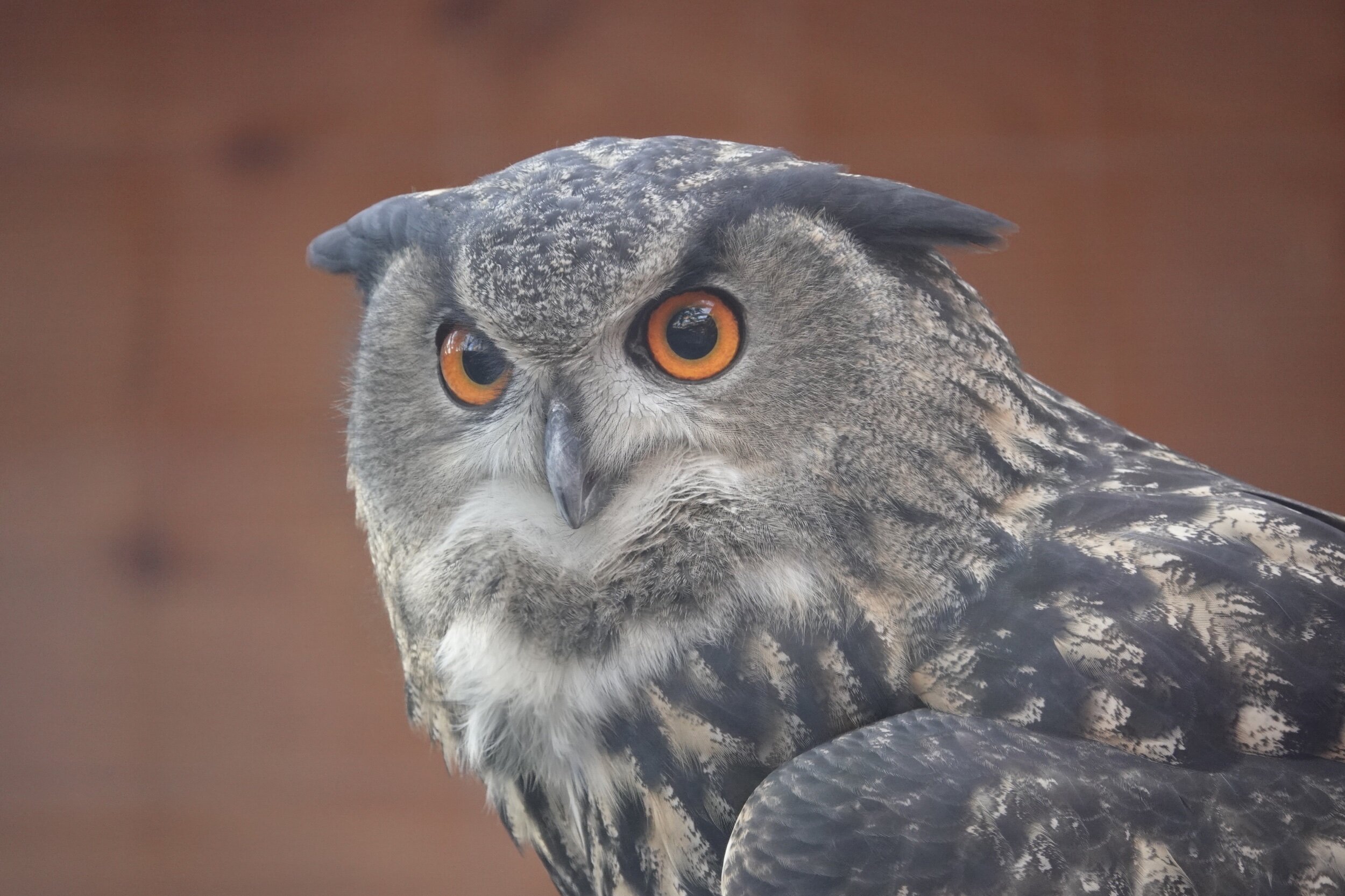
The Eurasian Eagle-owl at the American Bald Eagle Foundation in Haines, Alaska, is a crowd pleaser.

The Eurasian Eagle-owl at the American Bald Eagle Foundation in Haines, Alaska, is a crowd pleaser.
Naturally
I find the extraordinary in the ordinary.
Fall, summer and winter showed up in November and fought it
out. The air became crisper, the nights cozier and the socks woolier. The view out a window can be exquisite and some would argue there were days when the weather was best enjoyed that way. Especially when the wind with its cold teeth threatened to peel back the day.
A gray catbird was in my yard on Nov. 7. That's late for that bird species to be here. It was joined by immature Harris's sparrows, eastern bluebirds and drab-colored goldfinches galore. The cedar waxwing is a stylish bird, which means I have nothing in my closet it'd ever be caught wearing. A flock of waxwings fed on berries. The hum of farm equipment and the roar of tractor-trailer rigs swallowed any sounds the waxwings might have been making as I pulled impaled leaves from my rake.
Buckthorn has many branches and thorns. It keeps its leaves longer and greens up earlier than most deciduous trees. It sprouts profusely. I saw a great blue heron (Big Cranky, Long John or Poor Joe) standing as still as a statue along the Le Sueur River.
A woolly bear caterpillar moved across the walk. These caterpillars shed their skins several times and their colors change before fall. The caterpillar’s coat helps it survive winter. The woolly worm was searching for a place to curl up and hibernate until building a cocoon in the spring. The length of the bands is based on the caterpillar's age, with nutrition, genetics, habitat and species being other possible determinants.
It resembled a big mosquito but doesn't bite humans. It was a crane fly with a 1.5-inch long body and a 3-inch wingspread. In colloquial speech, crane flies are sometimes called mosquito hawks or daddy longlegs. To me, mosquito hawks are dragonflies and daddy longlegs are the arachnids called harvestmen. They aren't spiders. They don’t produce silk and aren't venomous. I've found daddy longlegs with fewer than eight legs because they'll shed legs grasped by predators and cannot regrow them.
Q&A
"My yard has noisy squirrels. What are they talking about?" A researcher at Auburn University wondered the same thing and learned the most common sounds squirrels make are danger warnings. The kuk is a sharp bark of alarm, usually issued in a series and intended for other squirrels and predators. The study showed that when a squirrel starts kukking, a cat gives up, knowing it had lost the element of surprise. The quaa sounds a bit like a cat screeching and is issued after the threat level has dropped. A quaa moan sounds like a chirp followed by a meow. It's ventriloquial, making it difficult to determine the sound's location. It's given in hopes the predator had left but suggests continued caution. Some experts claim to be able to tell if the squirrel is warning about an aerial or terrestrial predator. Muk-muk resembles a stifled sneeze or buzz-like phfft, phfft. Nesting squirrels use it when hungry and males make it during mating chases.
"How many trumpeter swans are there in Minnesota?" A 2015 statewide tally counted over 17,000 swans. A current estimate is 30,000. Some winter in Minnesota, settling on open water on the Mississippi River in Monticello (2,000 winter there) or along the St. Croix River. Native to Minnesota and the largest North American waterfowl species, trumpeter swans inhabited wetlands from Illinois northwest to Alaska. Throughout the 1800s, they were hunted for their meat (no supermarkets available) and feathers (some used for quill pens). Swan habitat diminished as settlers moved across North America. By the 1930s, an estimated 69 trumpeters remained in the lower 48 states, living in remote southeastern Montana. When the DNR started the swan reintroduction program in the 1980s, its goal was 350 swans.
"This fall, something made holes as big around as a pencil in my lawn. There were no mounds of dirt and the holes went down a few inches before stopping or turning. What is making them?" A northern flicker, with its white rump patch and black bib, creates holes like your description. The woodpecker regularly feeds on the ground, eating ants or grubs.
Thanks for stopping by
"It is perhaps a more fortunate destiny to have a taste for collecting shells than to be born a millionaire." — Robert Louis Stevenson
"Great blue heron is the color of gray mist reflecting in blue water. And like mist, she can fade into the backdrop, all of her disappearing except the concentric circles of her lock-and-load eyes. She is a patient, solitary hunter, standing alone as long as it takes to snatch her prey. Or, eyeing her catch, she will stride forward one slow step at a time, like a predacious bridesmaid. And yet, on rare occasions she hunts on the wing, darting and diving sharply, swordlike beak in the lead." ― Delia Owens, "Where the Crawdads Sing"
Do good.
©Al Batt 2020

There’s something fishy about a great blue heron’s diet, but it will eat anything that comes within striking distance. I’ve seen one eat birds, ground squirrels and chipmunks. Photo by Al Batt

A Great Gray Owl is great for an owl of any color.

The Hammer Museum in Haines, Alaska.

With a big enough hammer, a square peg will fit into a round hole.

Just like Blue Jays, Steller’s Jays love peanuts.

John Muir wrote, “I must break away and get out into the mountains and learn the news.” These are in Haines, Alaska.

This immature Bald Eagle had good luck fishing.

An oily photo of a lovely Rusty Blackbird.

A youngster, carrying some fancy binoculars, is a about to release a hawk at, of all places, Hawk Ridge in Duluth, Minnesota.

A White-throated Sparrow checks the menu.

It was either the bluebird of crankiness or the bluebird of Minneapolis.

This gang of ducks was hanging out at what they thought was a safe distance from the sign.

I don’t know if ducks believe in astrology, but none of them want to be under this sign.

Definitely not waterfowl.

The Red-breasted Nuthatch is a goober grabber.
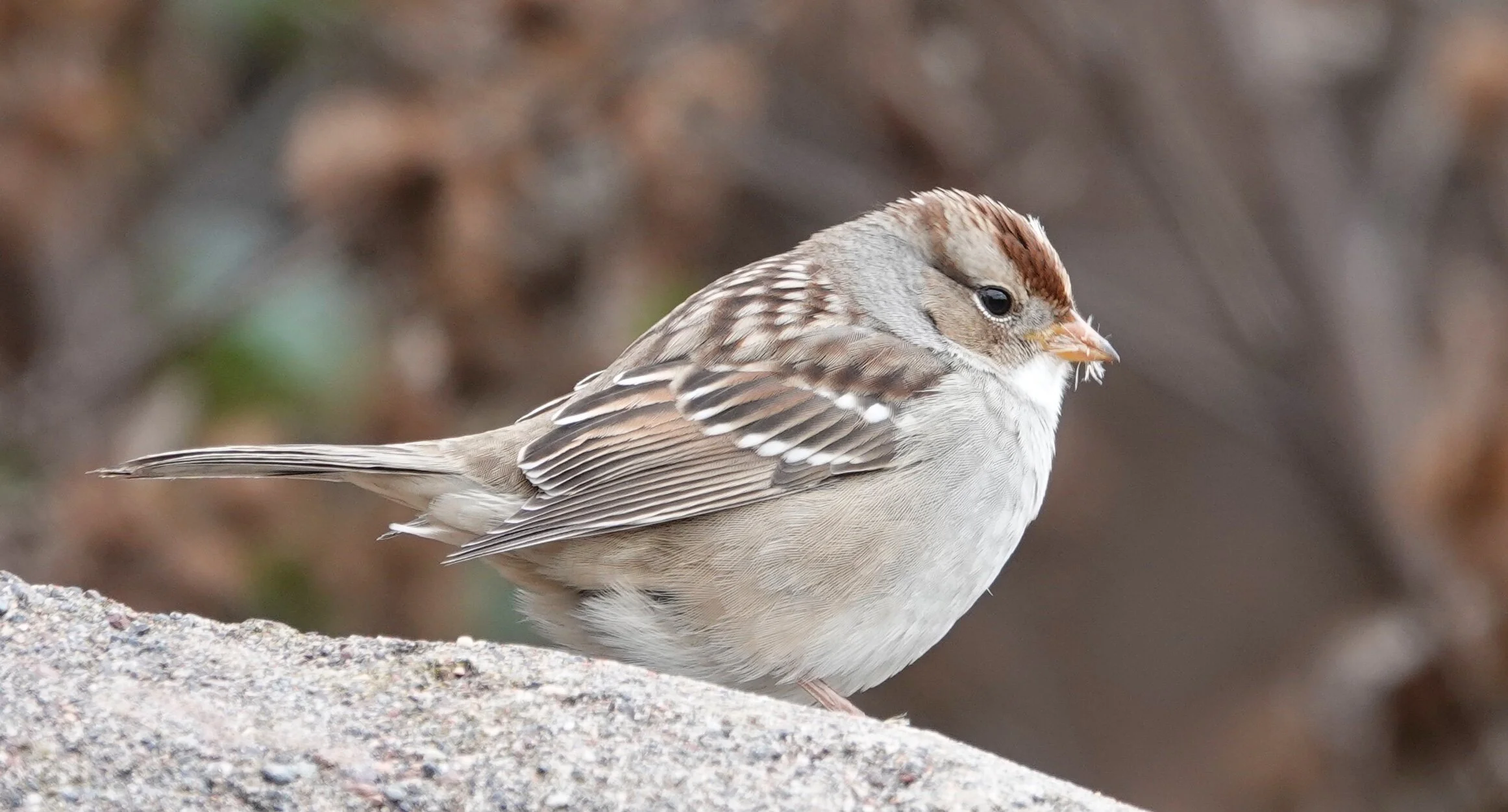
A White-crowned Sparrow looking princely while hoping to wear a white crown one day.
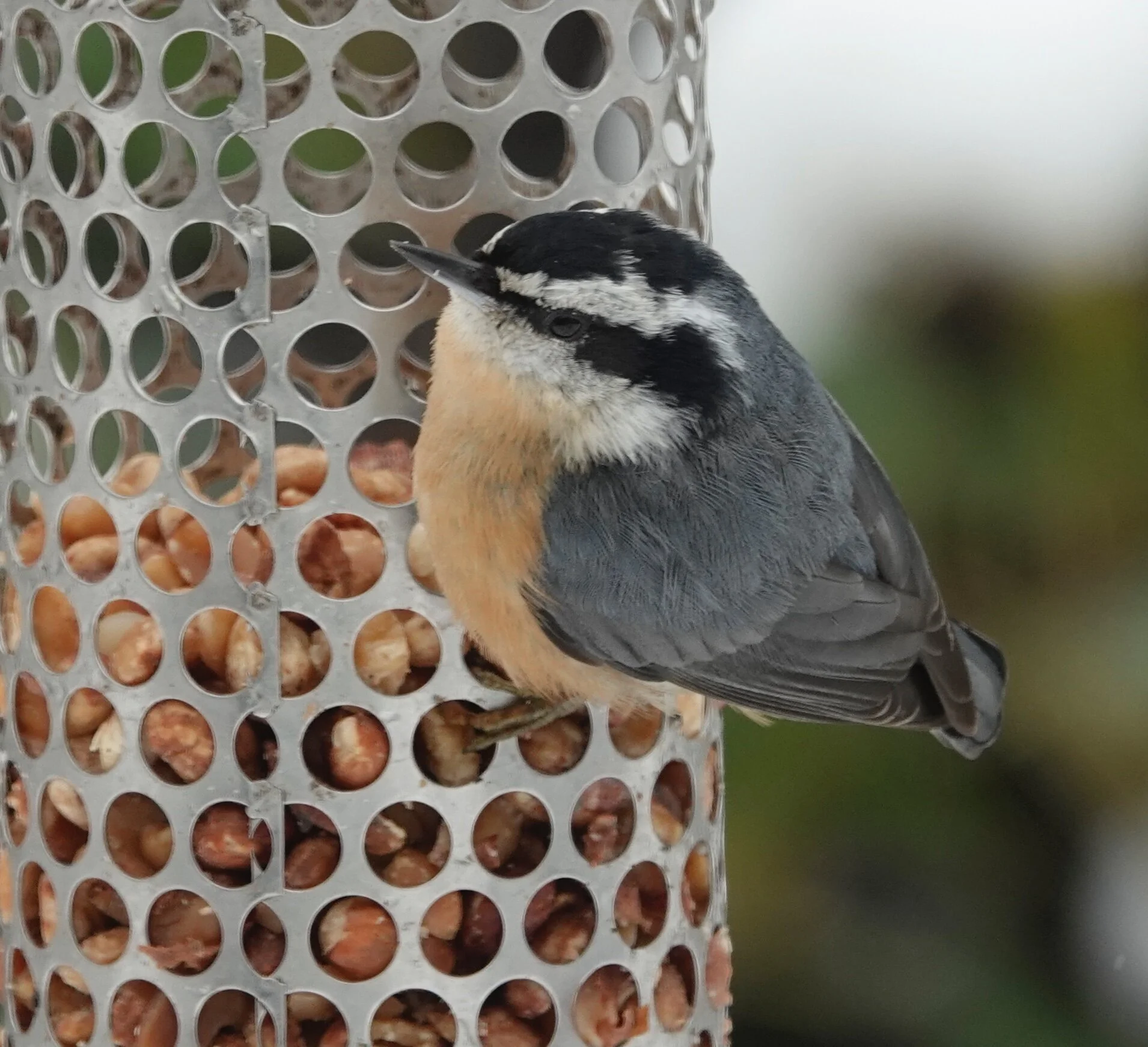
A Red-breasted Peanuthatch.
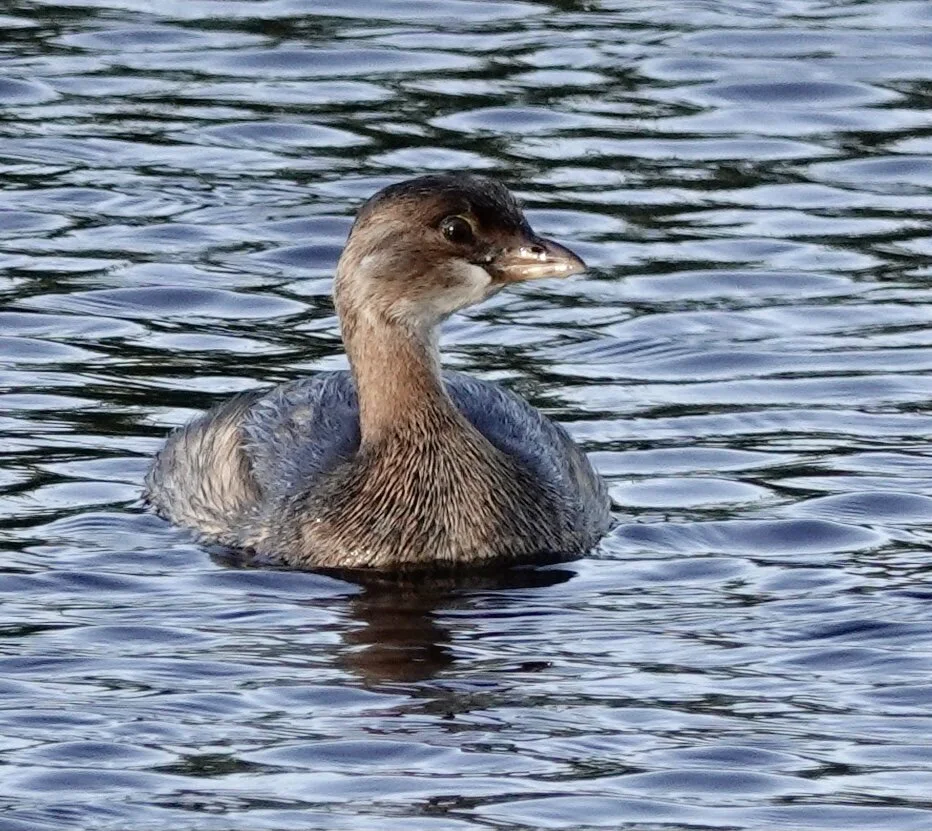
Would misidentifying a Pied-billed Grebe be a grebous error?
Naturally
The yard crows were kicking up a fuss. Crows can't keep a secret. There was a puff of cold wind that led to a puff of house sparrow. A bird’s body heat warms the air between its feathers, so birds fluff up in the cold to trap as much warm air in their feathers as possible. The more trapped air there is, the warmer the bird. An American goldfinch and a pine siskin shared a feeder table that allowed them to maintain social distancing. There was a chickadee eye looking everywhere. The Ginkgo tree completed its annual striptease by dropping all its leaves in a single day.
Q&A
"I have mullein growing on my property. Do birds feed on it?" Common mullein is a biennial that in its first year has a basal rosette of large, velvety leaves. Its second year produces a tall dried skeleton of seeds after the fuzzy stem has dropped its yellow, five-petalled flowers. Once it has gone to seed, mullein provides winter food for finches, chickadees and downy woodpeckers.
"I watched a blue jay pick up several peanuts in the shell on my feeder before flying off with one. What was it doing?" A study published in the Journal of Ornithology suggested that the bird was weighing peanuts and possibly shaking them to determine the quality. When presented with ten empty and ten full identical pods, the jays rejected the empty ones and accepted the full peanuts without opening them. The jays preferred the heavier nuts.
"What is the smallest mammal?" By total mass, the Etruscan shrew, a shrew species found from southern Europe to southern Asia, is the smallest mammal, weighing up to two grams. The bumblebee bat or Kitti’s hog-nosed bat occurring in Thailand and parts of Myanmar is the smallest mammal by length, measuring barely over an inch long. The smallest mammal in North America is the pygmy shrew, which weighs 0.07 ounces and has a body 1.5 to 2 inches long.
"Why don't I find many dead birds?" There is no secret avian graveyard. Vulnerable birds seek secluded places, hoping rest would help them recover. Scavengers and predators find those weak or deceased birds. Those that aren't found by predators or scavengers decompose rapidly, with the help of bacteria and insects.
"How much does a pelican eat?" According to the U.S Fish & Wildlife Service, an adult American white pelican consumes 20-40% of its body weight daily, with its average weight being 15 pounds, which means 3-6 pounds of fish per day. Approximately 150 pounds of food is needed to feed one chick from hatching to fledging. The food caught is always swallowed, never carried in a pouch.
"Have you heard about Bird Names For Birds?" It's a campaign to abandon eponyms in taxonomy and honorific common names for birds to support equity, diversity and inclusion in the American birding community. The campaign writes "Eponyms (a person after whom a discovery, invention, place, etc., is named or thought to be named) and honorific common bird names (a name given to something in honor of a person) are problematic because they perpetuate colonialism and the racism associated with it. The names that these birds currently have—for example, Bachman’s Sparrow — represent and remember people (mainly white men) who often have objectively horrible pasts and do not uphold the morals and standards the bird community should memorialize." I wouldn't be unhappy with more descriptive names.
"What bird migrates the farthest?" The arctic tern breeds in the Arctic and sub-Arctic and winters in the Antarctic. Tracking studies have found the birds make annual journeys of about 44,100 miles, with one bird flying round trip from England to Antarctica on a journey of 59,650 miles.
"Were canaries used in coal mines or is it just a story?" Canaries are early detectors of carbon monoxide because they’re vulnerable to airborne poisons. In 1986, a mining tradition dating back to 1911 ended the use of canaries in coal mines to detect carbon monoxide and other toxic gases before they were harmful to humans.
"Why is Iowa the Hawkeye State?" The nickname was partially inspired by the scout, Hawkeye, in James Fenimore Cooper's "The Last of the Mohicans" and was suggested as a tribute to Chief Black Hawk.
Thanks for stopping by
"We have probed the earth, excavated it, burned it, ripped things from it, buried things in it, chopped down its forests, leveled its hills, muddied its waters, and dirtied its air. That does not fit my definition of a good tenant. If we were here on a month-to-month basis, we would have been evicted long ago." — Rose Bird, the late Chief Justice of California Supreme Court
"Too many people spend money they haven't earned, to buy things they don't want, to impress people they don't like." —Will Rogers
Do good.
©Al Batt 2020

A pine siskin can store up to 10% of its body weight in seeds inside its crop to sustain the bird during frigid nighttime temperatures. Photo by Al Batt

I thought by now you'd realize There ain't no way to hide your lion eyes.

I have fond memories of September and its flowers, bees and soldier beetles.

After learning there were no squirrels in Iceland, this one made travel plans.

A Red-breasted Nuthatch. Another term for “cute.”

A threshing machine in retirement.

If life gives you hay, you build a tractor.

A house finch and her shadow.


The stigmas or white dots on the tips of the wings indicate that this Ebony Jewelwing damselfly is a female.

A mining bee mining its own business in North Dakota.
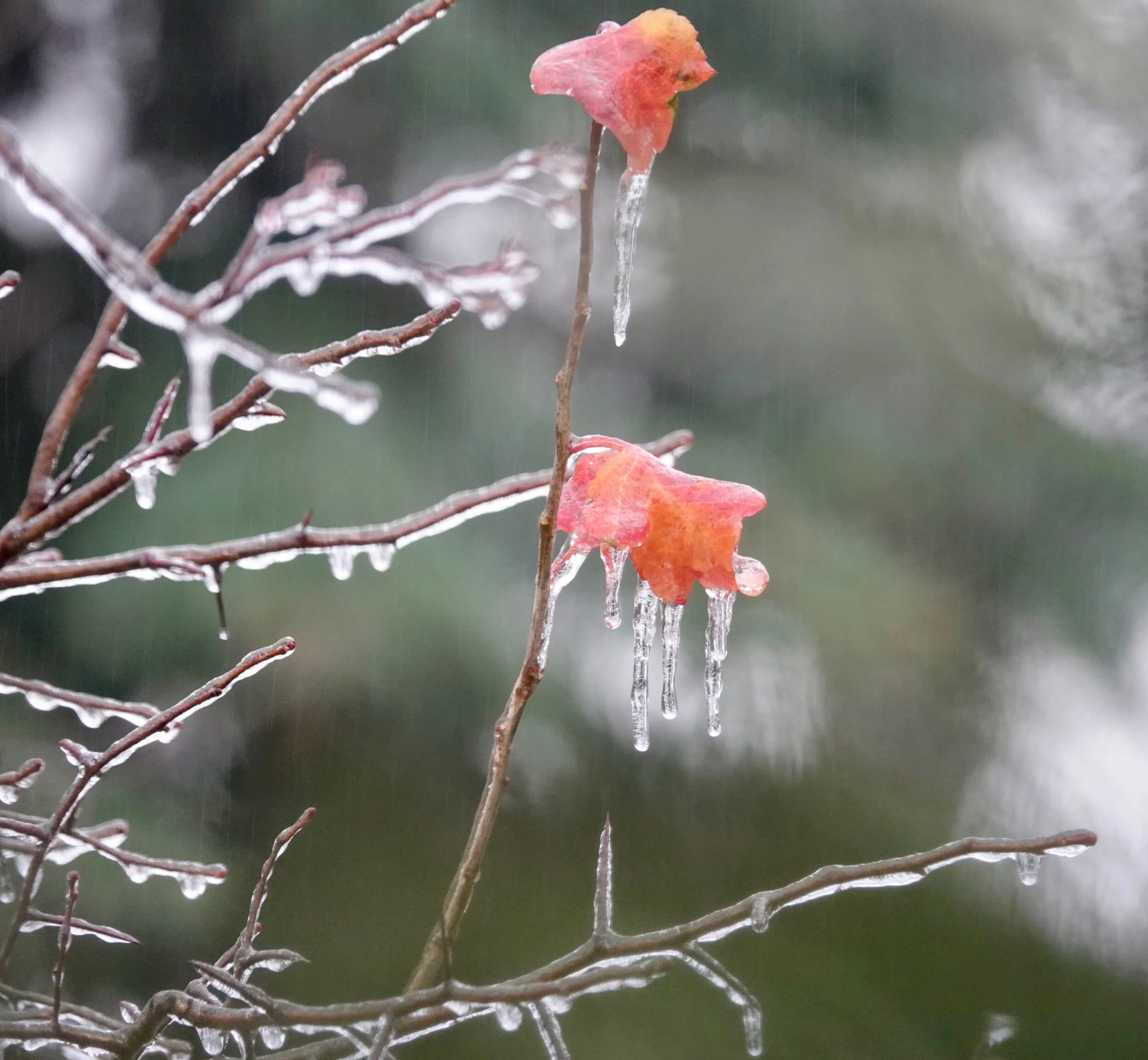
It was water before it was cool.
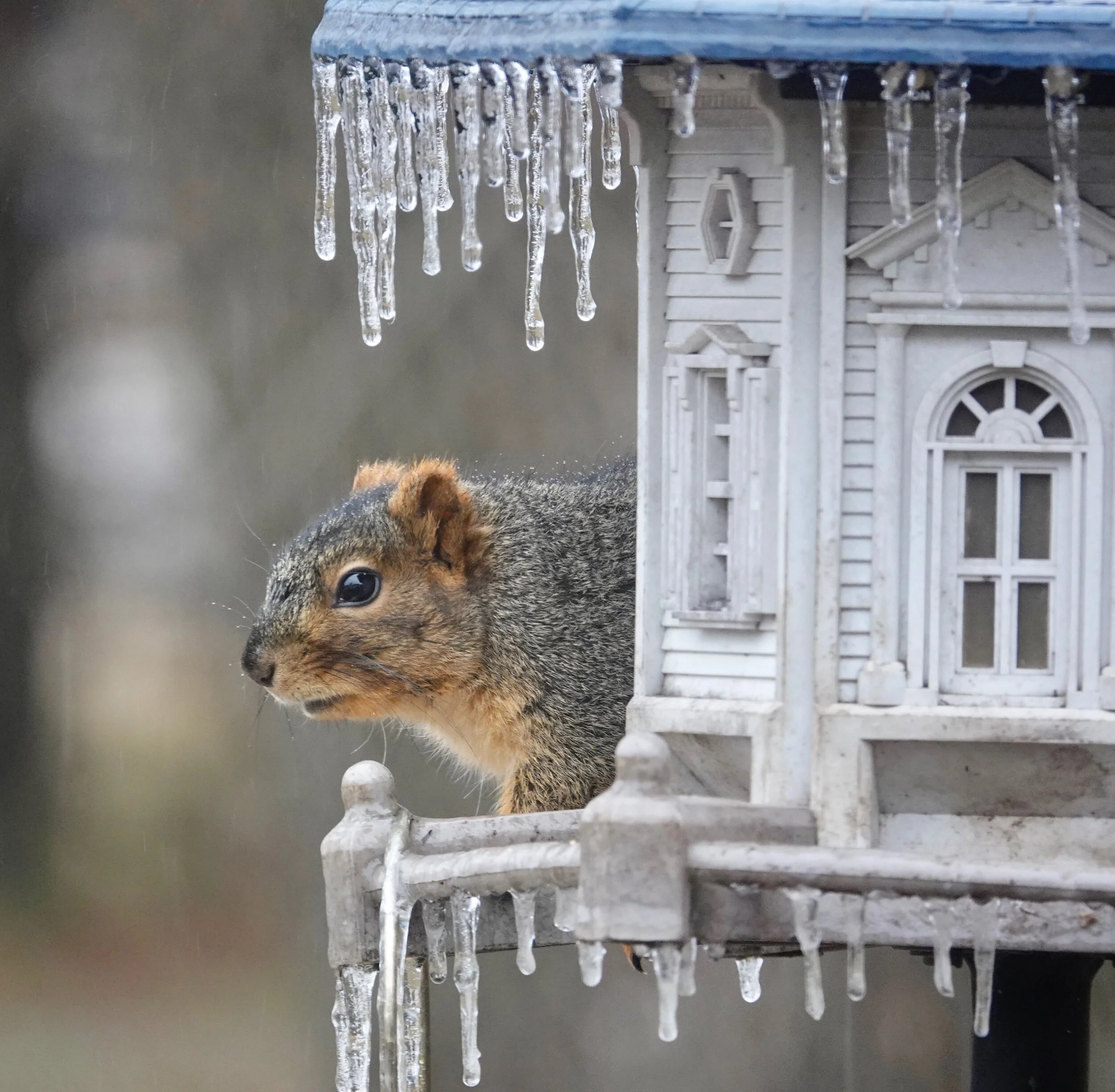
It looked like an ice day to the squirrel.
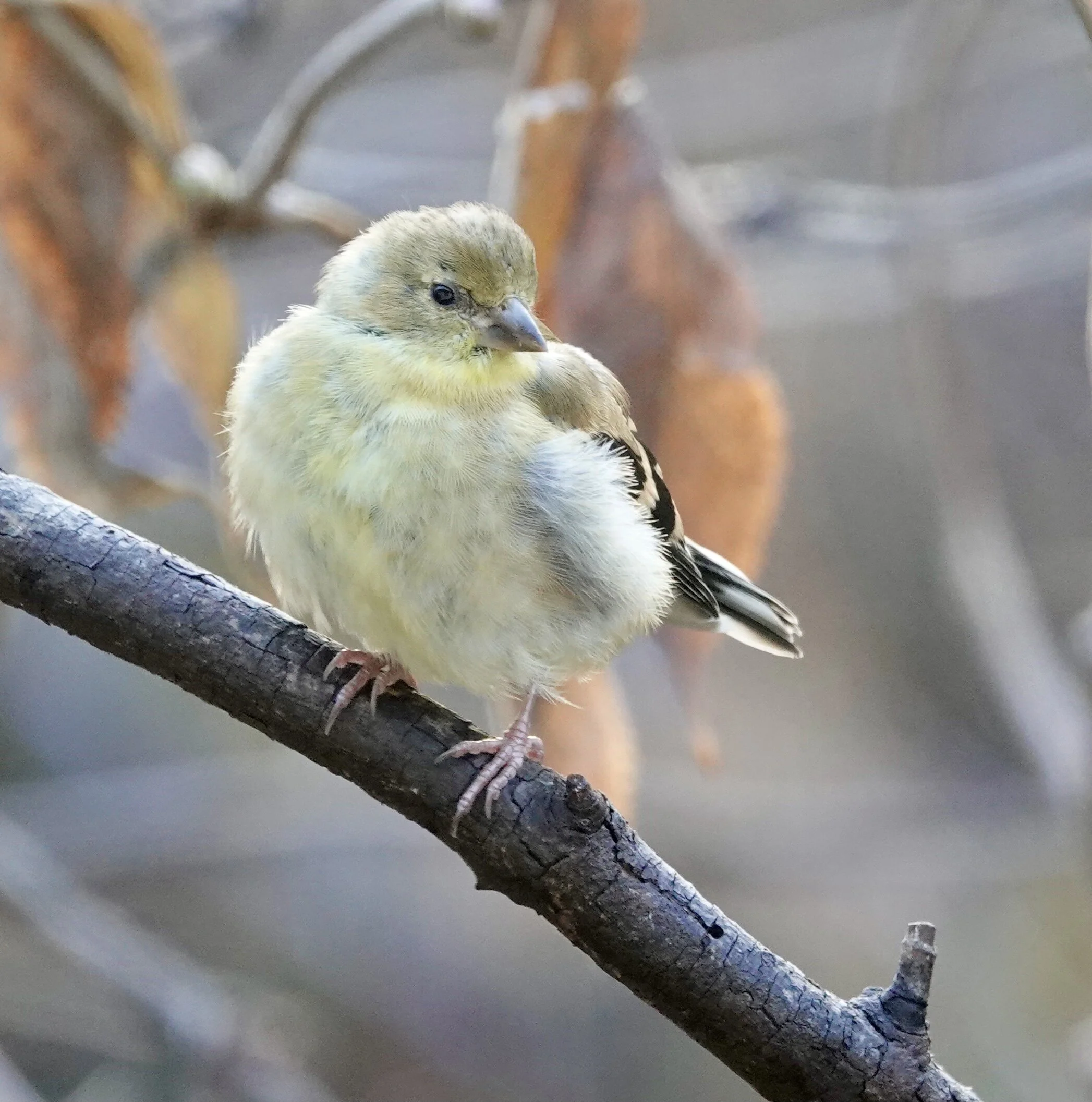
Sugar and spice and everything ice. Except for this American Goldfinch, which was everything nice.
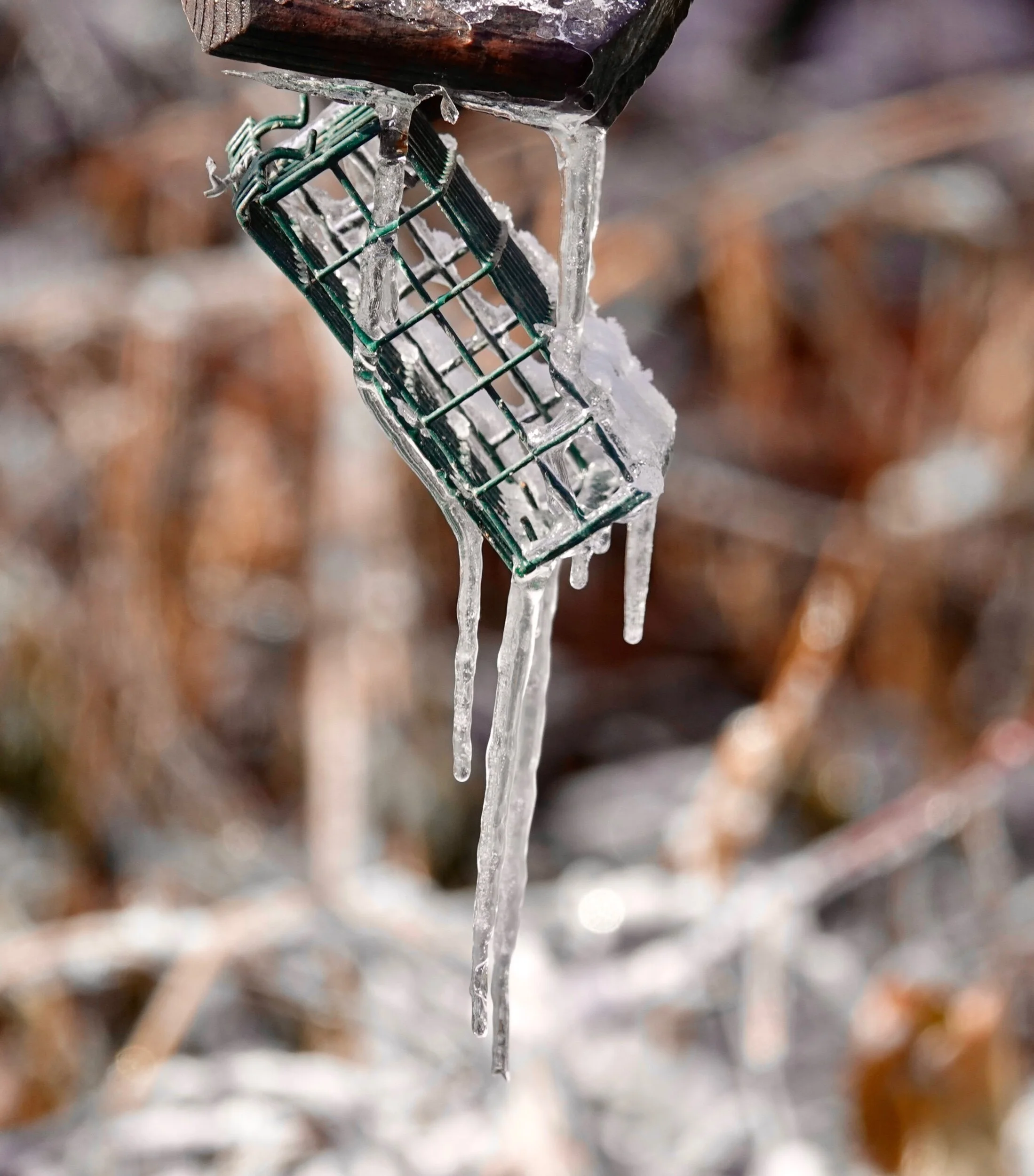
If I’d have known the weather was coming, I’d have baked a suet cake.

A Harlequin Duck might carry a wooden sword or a magic wand. Or maybe a romance novel.

Starling light, starling bright, The last starling I see tonight; I wish I may, I wish I might, Have the wish I wish tonight.

A raven seen just 4,449 miles outside the Tower of London.

A Great Blue Heron (Big Cranky, Long John or Poor Joe) stands as still as a statue.

The Cedar Waxwing is a stylish bird, which means I have nothing in my closet that it would ever be caught wearing.

A duck walks into a bar. “Waddle it be?” asked the bartender.

Why did the headless Great Blue Heron stand on one leg? Because if it didn’t, it would have fallen over.

The gales of November came early — October.
Naturally
The snowbirds (juncos) found snow here in October. They were likely no more excited about it than I was. The weather, though disagreeable, wasn't completely without a good side. It ended the reign of terror of the minute pirate bugs, the things disguised as nothing that bite us. They are attracted to people wearing light-colored clothing and bite with an impact far above their weight class. The weather moved birds to my feeders and waterer. For this hick from the sticks, seeing three redbirds in a single tree in my yard is a highlight.
I watched robins feed in a hawthorn tree. I realized a robin has a great sense of humor. It enjoys a good haw. Woodpeckers also sampled the haws. A hairy woodpecker visited the suet. It hammered away. "Give 'em hell, Hairy," I said. "Give 'em hell, Harry" was a play and film based on Harry Truman. How much wood would a woodpecker peck if a woodpecker would peck wood? I’ve been hearing from homeowners with cedar shakes who are learning the answer to that question the hard way. Male house finches give the yard's feeders a rosy outlook. A lovely singer, the house finch was once sold in the illegal pet trade as a Hollywood finch. I'm not sure if blue jays will work for peanuts, but they will fly in and vocalize for peanuts.
Starlings (numerous, quarrelsome and ravenous) moved into the yard like Cousin Eddie's family in the National Lampoon's Vacation film series. An eastern phoebe did likewise in 27° weather. The flycatcher perched on a feeder sheltered from the snow and looked up for flying insects to eat. I hoped things looked up for that phoebe. A single white-crowned sparrow, with racing stripes on its noggin fed below the feeders with the fox sparrows. The sight of br'er fox sparrow caused me to say "The quick brown fox sparrow jumps over the lazy dog," a pangram — a sentence that contains all the letters of the alphabet. With the color of its plumage, even when doing what it's always done, a fox sparrow looks rusty.
The wind picked up and made the beautiful leaves dance in the air. John Critchley Prince wrote, "Ruffling the colors of the forest leaves, the winds make music as they come and go." I examined a tree along a lake. It had been gnawed by a beaver.
The words "And Jerry Mathers as the Beaver" ran through my mind. I marveled at the beauty of trumpeter swans, which can take the cold and will winter where there is open water. In winter, they feed upon grasses, grains, roots and tubers. They get much of their food by dabbling, feeding on whatever submerged vegetation within reach of their long necks.
I'll miss going to Texas for speaking and birding this year. I love saying "chachalaca" and "kiskadee." I'll find solace in recalling the sight of such incredible birds as green jays, blue mockingbird, red-crowned parrots, green kingfishers, Altamira orioles, aplomado falcons, least grebes, northern beardless-tyrannulets, greater peewee and many others in the Lower Rio Grande Valley.
The mushrooms have gone with the cold, leaving my yard a spore loser, but Halloween brought thoughts of owls. Young owls leave their parents and move to new territories in the fall. Inexperienced birds with glowing eyes, quiet wings and eerie voices (a fall night can provide wonderful acoustics) make them seem otherworldly when their juvenile dispersal causes them to show up in odd places.
Q&A
"I listen to your radio show. You said house sparrow populations are declining in London. Why?" London's house sparrows have plummeted by 71% since 1995, with new research suggesting avian malaria could be the cause. Similar to human malaria, it's spread by mosquitoes, which transfer the parasite to healthy birds. The parasite reproduces in red blood cells and other tissues, and in severe cases can be fatal. Avian malaria is not a danger to humans.
"What is the oldest banded bird?" Wisdom, a female Laysan albatross, is the oldest known banded bird in the wild. She nests in the world's largest albatross colony, which is located on Midway Atoll National Wildlife Refuge. She is at least 70-years old and as difficult it is to believe, was not discovered while she was reading a membership solicitation from AARP.
Thanks for stopping by
Journalist Ed Murrow: "Who owns the patent on this vaccine?" Jonas Salk, developer of polio vaccine: "Well, the people, I would say. There is no patent. Could you patent the sun?"
"The old Lakota was wise. He loved the earth and all things of the earth. He knew that man's heart away from nature becomes hard. He knew that lack of respect for growing, living things soon leads to lack of respect for humans too." — Chief Luther Standing Bear
Do good.
©Al Batt 2020

I watched robins feed in a hawthorn tree. I realized a robin has a great sense of humor. It enjoys a good haw. Photo by Al Batt

I love the breathy wolf-whistle of the Upland Sandpiper. An uppie is never a downer.
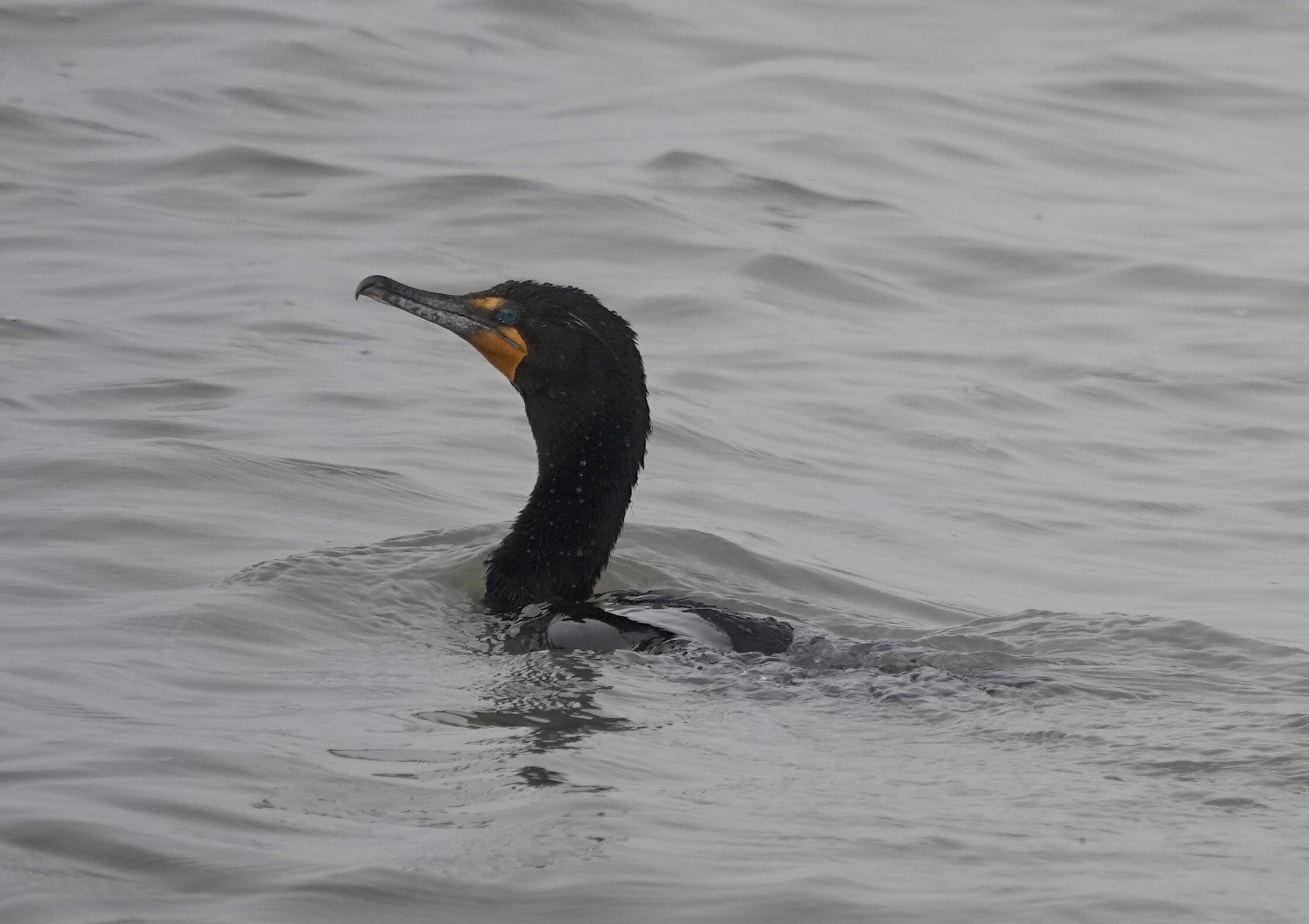
A Double-crested Cormorant with eyes a dazzling blue — enough to have made Jack Benny nervous.

The American Bittern has a flock of nicknames — barrel-maker, belcher squelcher, bog-bull, bog-hen, bog-trotter, butter bump, dunk-a-doo, mire-drum, night-hen, plum puddin', post-driver, slough pumper, stake-driver, sun-gazer, thunder-pumper and water-belcher.

November. No wonder there is so much wonder.

This woolly bear caterpillar stayed in its lane.

A Song Sparrow in a crooked forest.
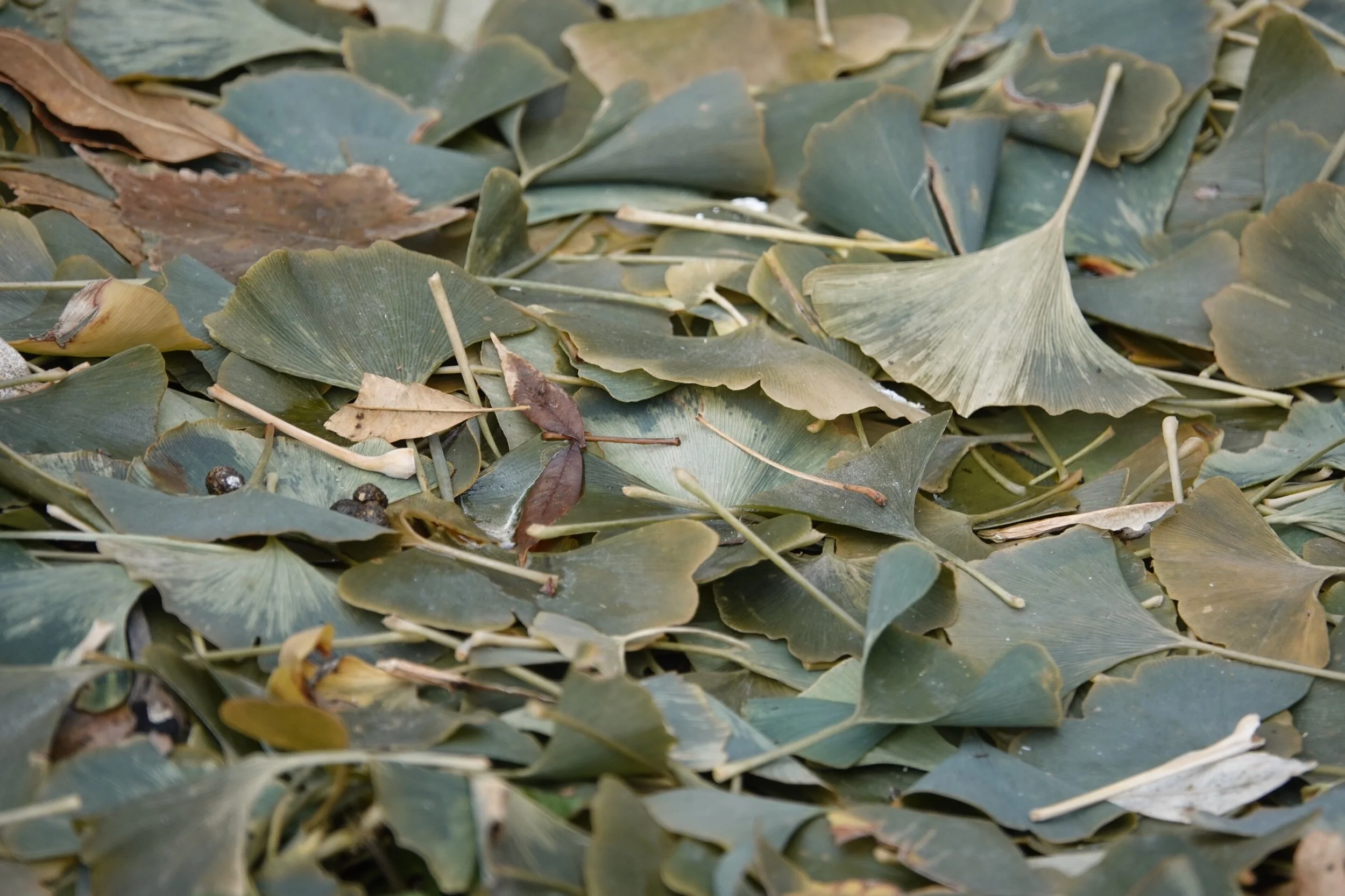
The Ginkgo tree has completed its annual striptease — dropping all its leaves in one day.
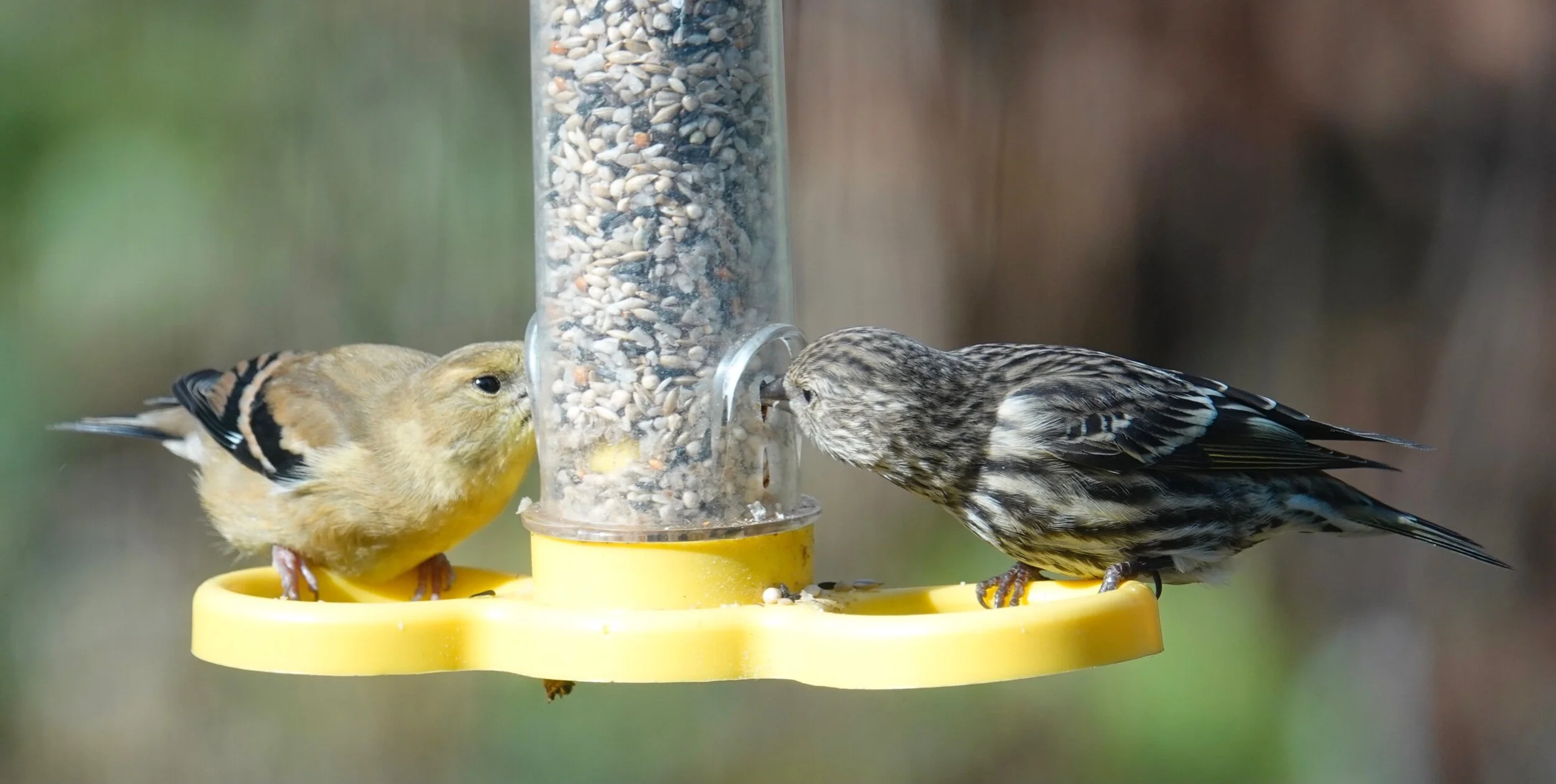
An American Goldfinch and a Pine Siskin share a table that allows them to maintain social distancing.
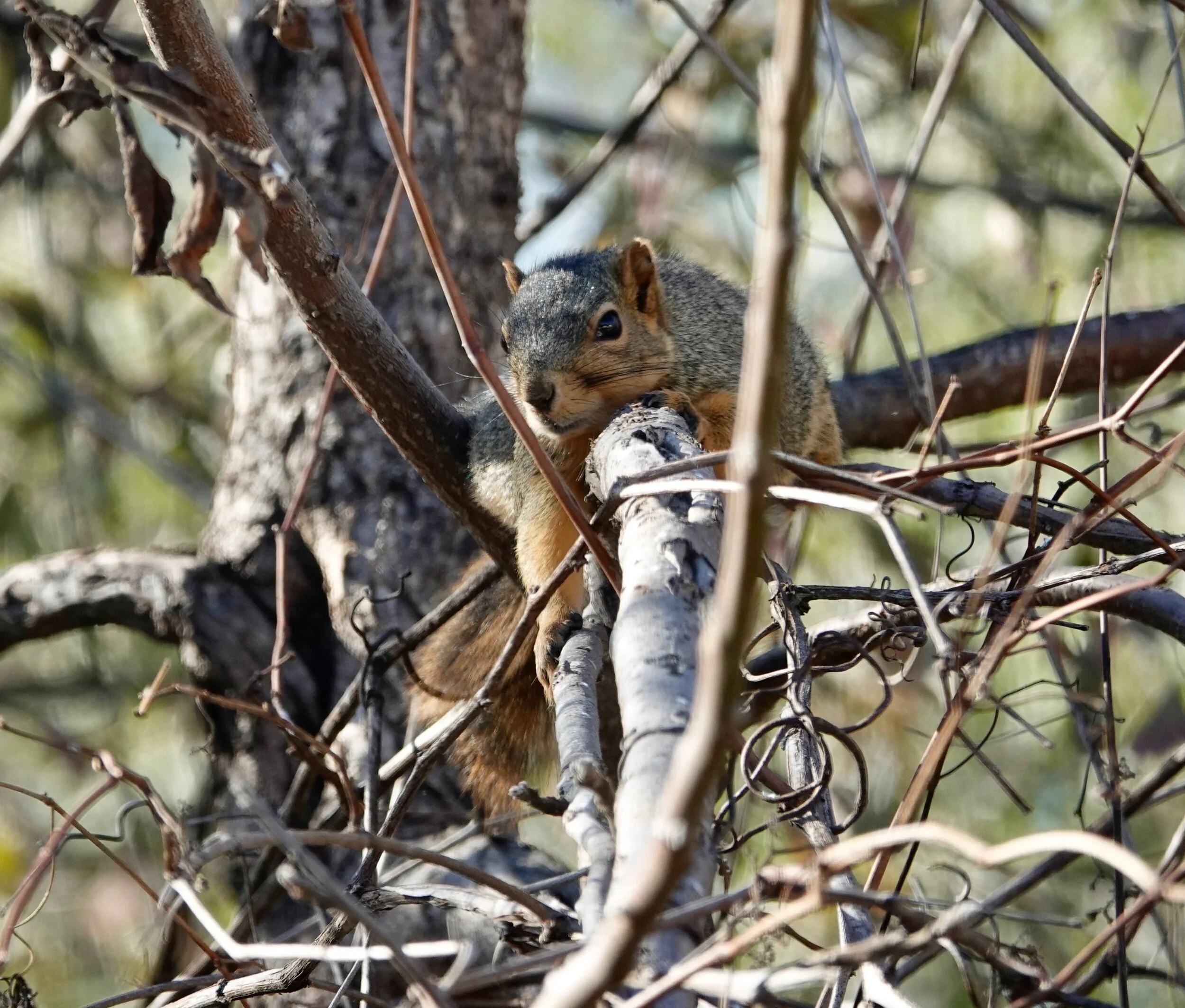
In the jungle, the mighty jungle, the squirrel considers a nap.

There was a puff of cold wind that led to a puff of House Sparrow.

An amazing carving of a Northern Hawk Owl seen at a shop in the subway level of the Mayo Clinic in Rochester, Minnesota. The talent of the carvers is astounding.

Cold yoga for woodpeckers.

A cardinal about to cannonball into the pool.